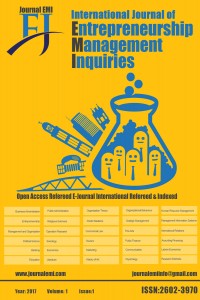Research Article
Year 2017,
Volume: 1 Issue: 1, 1 - 7, 26.12.2017
Abstract
Araştırmacılar, orijinal amacı olan, siyasi ve sosyolojik bilimlerde nitel karşılaştırmalı analiz (QCA) yöntemini işletme yönetimi alanında uyguluyorlar. Bu makale QCA’ nın işletme yönetimi araştırmalarındaki kullanımlarını gözden geçirmektedir. Bu çalışma, QCA’ nın ampirik bir tekniğin ötesine nasıl taşındığını ve bu yöntemin, yeni bilgi yolları açan niteliksel analizin orijinal bir biçimlendirmesini nasıl sunduğunu göstermektedir.
References
- Curchod, C. (2003). The comparative method in management science: Towards a qualiquantitative approach to managerial reality. Finance, Control and Strategy Dergisi, Cilt 6-2, Sayfa 155–177.
- De Meur, G., & Rihoux, B. (2002). The qualitative comparative analysis (QCA-QCA): Approach, humanities and technical applications. Leuven: Academia-Bruylant.
- Duşa, A. (2007). User manual for the QCA(GUI) package in R. Business Research Dergisi, Cilt 60-5, Sayfa 576–586.
- Fiss, P.C. (2007). A set-theoretic approach to organizational configurations. Academy of Management Review Dergisi, Cilt 32-4, Sayfa 1180–1198.
- Fiss, P.C. (2011), Building better causal theories: a fuzzy set approach to typologies in organization research, academy of management journal dergisi, Cilt 54, Sayı 2, Sayfa 393-420.
- Ford, L.R., Seers, A., & Neumann, J. (2013). Honoring complexity: Set-theoretic analysis as a complementary method in leadership research. Management Research Review Dergisi, Cilt 36-7, Sayfa 644–663.
- Ganter, A., & Hecker, A. (2013). Configurational paths to organizational innovation: Qualitative comparative analyses of antecedents and contingencies. Journal of Business Research Dergisi, Cilt 676, Sayfa 1285–1292.
- Järvinen, J., Lamberg, J. -A.,Murmann, J. -P., & Ojala, J. (2009). Alternative paths to competitive advantage: A fuzzy-set analysis of the origins of large firms. Industry and Innovation Dergisi, Cilt 16-6, Sayfa 545–574.
- Judge, W.Q., Fainshmidt, S., & Brown Iii, J.L. (2014). Which model of capitalism best delivers both wealth and equality? International Business Studies Dergisi, Cilt 45-4, Sayfa 363–386.
- Kent, R. (2009). Rethinking data analysis—Part one. International Journal of Market Research Dergisi, Cilt 51-1, Sayfa 51–69. Kent, R.A. (2005). Cases as configurations: Using combinatorial and fuzzy logic to analyse marketing data. International Journal of Market Research Dergisi, Cilt 47-2, Sayfa 205–228.
- Kitchener, M., Beynon, M., & Harrington, C. (2002). Qualitative comparative analysis and public services research: Lessons from an early application. Public Management Review Dergisi, Cilt 4-4, Sayfa 485–504.
- Koll, O., Woodside, A.G., & Mühlbacher, H. (2005). Balanced versus focused responsiveness to core constituencies and organizational effectiveness. European Journal of Marketing Dergisi, Cilt 39 Sayı 9– 10, Sayfa 1166–1183.
- Miles, M.B., & Huberman, A.M. (2003). Qualitative data analysis (2 ed.). Oxford: Oxford University Press.
- Ragin, C.C. (1987). The comparative method: Moving beyond qualitative and quantitative Strategies. Berkeley, CA: University of California Press.
- Ragin, Charles C. (2008). "Qualitative Comparative Analysis Using Fuzzy Sets (fsQCA).",Sage Publitions, Londra, Sayfa 87-121.
- Rihoux, B., & Marx, A. (2013). Qualitative comparative analysis at 25: State of play and agenda. Political Research Quarterly Dergisi, Cilt 66-1, Sayfa 167–171.
- Rihoux, B., Álamos-Concha, P., Bol, D., Marx, A., & Rezsöhazy, I. (2013). From niche to mainstream method? A comprehensive mapping of QCA applications in journal articles from 1984 to 2011. Political Research Quarterly Dergisi, Cilt 66-1, Sayfa 175–184.
- Woodside, A.G. (2008). Anti-social behaviour: Profiling the lives behind road rage. Marketing Intelligence & Planning Dergisi, Cilt 26-5, Sayfa 49–480.
- Woodside, A.G., & Baxter, R. (2013). Achieving accuracy, generalization-to-contexts, and complexity in theories of business-to-business decision processes. Industrial Marketing Management Dergisi, Cilt 423, Sayfa 382–393.
- Zadeh, Lotfi (1965), "Fuzzy Sets." , Information and Control Dergisi, Sayı 8-338, Sayfa: 53.
Year 2017,
Volume: 1 Issue: 1, 1 - 7, 26.12.2017
Abstract
References
- Curchod, C. (2003). The comparative method in management science: Towards a qualiquantitative approach to managerial reality. Finance, Control and Strategy Dergisi, Cilt 6-2, Sayfa 155–177.
- De Meur, G., & Rihoux, B. (2002). The qualitative comparative analysis (QCA-QCA): Approach, humanities and technical applications. Leuven: Academia-Bruylant.
- Duşa, A. (2007). User manual for the QCA(GUI) package in R. Business Research Dergisi, Cilt 60-5, Sayfa 576–586.
- Fiss, P.C. (2007). A set-theoretic approach to organizational configurations. Academy of Management Review Dergisi, Cilt 32-4, Sayfa 1180–1198.
- Fiss, P.C. (2011), Building better causal theories: a fuzzy set approach to typologies in organization research, academy of management journal dergisi, Cilt 54, Sayı 2, Sayfa 393-420.
- Ford, L.R., Seers, A., & Neumann, J. (2013). Honoring complexity: Set-theoretic analysis as a complementary method in leadership research. Management Research Review Dergisi, Cilt 36-7, Sayfa 644–663.
- Ganter, A., & Hecker, A. (2013). Configurational paths to organizational innovation: Qualitative comparative analyses of antecedents and contingencies. Journal of Business Research Dergisi, Cilt 676, Sayfa 1285–1292.
- Järvinen, J., Lamberg, J. -A.,Murmann, J. -P., & Ojala, J. (2009). Alternative paths to competitive advantage: A fuzzy-set analysis of the origins of large firms. Industry and Innovation Dergisi, Cilt 16-6, Sayfa 545–574.
- Judge, W.Q., Fainshmidt, S., & Brown Iii, J.L. (2014). Which model of capitalism best delivers both wealth and equality? International Business Studies Dergisi, Cilt 45-4, Sayfa 363–386.
- Kent, R. (2009). Rethinking data analysis—Part one. International Journal of Market Research Dergisi, Cilt 51-1, Sayfa 51–69. Kent, R.A. (2005). Cases as configurations: Using combinatorial and fuzzy logic to analyse marketing data. International Journal of Market Research Dergisi, Cilt 47-2, Sayfa 205–228.
- Kitchener, M., Beynon, M., & Harrington, C. (2002). Qualitative comparative analysis and public services research: Lessons from an early application. Public Management Review Dergisi, Cilt 4-4, Sayfa 485–504.
- Koll, O., Woodside, A.G., & Mühlbacher, H. (2005). Balanced versus focused responsiveness to core constituencies and organizational effectiveness. European Journal of Marketing Dergisi, Cilt 39 Sayı 9– 10, Sayfa 1166–1183.
- Miles, M.B., & Huberman, A.M. (2003). Qualitative data analysis (2 ed.). Oxford: Oxford University Press.
- Ragin, C.C. (1987). The comparative method: Moving beyond qualitative and quantitative Strategies. Berkeley, CA: University of California Press.
- Ragin, Charles C. (2008). "Qualitative Comparative Analysis Using Fuzzy Sets (fsQCA).",Sage Publitions, Londra, Sayfa 87-121.
- Rihoux, B., & Marx, A. (2013). Qualitative comparative analysis at 25: State of play and agenda. Political Research Quarterly Dergisi, Cilt 66-1, Sayfa 167–171.
- Rihoux, B., Álamos-Concha, P., Bol, D., Marx, A., & Rezsöhazy, I. (2013). From niche to mainstream method? A comprehensive mapping of QCA applications in journal articles from 1984 to 2011. Political Research Quarterly Dergisi, Cilt 66-1, Sayfa 175–184.
- Woodside, A.G. (2008). Anti-social behaviour: Profiling the lives behind road rage. Marketing Intelligence & Planning Dergisi, Cilt 26-5, Sayfa 49–480.
- Woodside, A.G., & Baxter, R. (2013). Achieving accuracy, generalization-to-contexts, and complexity in theories of business-to-business decision processes. Industrial Marketing Management Dergisi, Cilt 423, Sayfa 382–393.
- Zadeh, Lotfi (1965), "Fuzzy Sets." , Information and Control Dergisi, Sayı 8-338, Sayfa: 53.
There are 20 citations in total.
Details
| Primary Language | English |
|---|---|
| Subjects | Economics |
| Journal Section | Articles |
| Authors | |
| Publication Date | December 26, 2017 |
| Submission Date | December 12, 2017 |
| Acceptance Date | December 20, 2017 |
| Published in Issue | Year 2017 Volume: 1 Issue: 1 |



Journal EMI e-mail Adresi: internationaljournalemi@gmail.com
JOURNAL EMI Creative Commons Attribution 4.0 Uluslararası Lisansı ile lisanslanmıştır.


